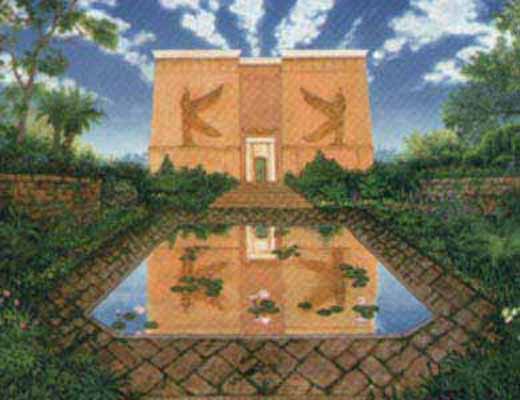

Egypt, before the dawn of history was teeming with trees. Of these trees are the petrified forests that are near the Giza pyramids and beside El Mokattam plateau. Egyptian Pharaohs planted trees and took care of them. They brought ebony wood from the Sudan, pine and cedar from Syria. Egyptian Pharaohs planted sant trees, sycamore, lotus fruits and willow.
At the time of the Crusades, Egypt had paid more attention to cultivating wood trees, to build marine fleet. There were 20,000 feddans of trees cultivated on both sides of Nile from Gerga to Aswan. The Ayobians planted forests in Upper Egypt from Beni Swif to Assuit. By the end of the Crusades, there were little attention paid for planting wood trees, until Mohamed Ali El Kabeer took the reign of Egypt. He was concerned about planting wood trees to build the Egyptian fleet.
At present there is great attention paid to cultivating trees on the farms' borders, road sides, canals, drainage, around villages, on the sandy hills near the Mediterranean shores, especially the multi-purposes trees, such as sycamore, mulberry, lotus among others.
These trees give fruits and are wind shields; providing shade, air purification, producing wood for the purposes of carpentry, fuel and making coal.
Sycamore trees have been cultivated since a very long time. Pharaohs called them Nehet. The oldest sycamore tree in Egypt is in Matarria and is known as Virgin Mary Tree. Sycamore tree lives long and bears sun exposure and humidity. Ancient Egyptians used them in making the wood monuments, such as the statue of the chief of the village from the Fourth Dynasty. In the time of Mohamed Ali El Kabeer, sycamore tree was used in making the bases for artillery units.
Sycamores exist in all Egyptian districts of Delta and Upper Egypt, also in the oases. It is considered a popular fruit in villages. Sycamore wood has special characteristics if immersed in water. It is used frequently in making water wheels, water wells and also agricultural tools. These trees are beautiful and shady, so they are cultivated on wide road sides.
Sycamore is an ever green large tree. Its height reaches 20 meters, when it is fully grown. Its branches spread horizontally over a diameter ranging 15-20 meters, therefore it is planted in 15-20 meters spacing. The fruit is carried on special branches that come from green branches. Flowers appear in sycamore when the age of the tree is ranging from 5 to 6 years old. Sycamore fruit is like fig in form and structure.
There are three main seasons for sycamore: the first season in the beginning of April, the second in the beginning of May and the third in the beginning of June. The fruit continues meagerly, especially in winter and autumn. An operation is usually run for fruits called circumcision in the early morning or afternoon when the age of the fruit ranges for 20 to 25. They make splits in the tops of fruit whose diameter extends from 1.5 to 2 cm2.
As the sycamore doesn't give seeds in Egypt so its proliferation is effected by transplants planted at the end of February and in March. This is the appropriate time for proliferation of trees. Sycamore grows fast under conditions of earth humidity. When the tree reaches the age of proliferation, the cultivators make circle around the tree by beating. Kinds of sycamore are:
The original native place of lotus tree is south Europe and Hemallaya moutons north of China. It is naturally grown in Egypt in the Sinai peninsula, Elba mouton, Nubia, besides Ethiopia and the Arabian peninsula.
One of the largest valleys in Sinai is known as the Valley of Lotus, as it is cultivated in Egypt since the oldest ages. It was known to the Egyptian Pharaohs as Nebes. In the past in Egypt, lotus fruit was cultivated in all houses, in their court yards. Lotus trees nowadays grow in Upper Egypt.
The original native country of doom is the Congo. It is also grown up in the desert of Hegaz. Doom trees are planted on the Nile banks in Nubia, and the Dakhela and Kharja Oases, also in Dendara, facing Qena, Aswan and in the Sudan in Kerdefan.
Doom cultivation flourished at the days of Pharaohs. It was called "Mama en Khenet". Doom trees were formed with the monuments in the age back to 1500 years BC. Doom tree branches are used as ceiling for buildings, because they are stronger than palm tree branches, as they are closely mixed and interlaced. Doom is able to bear the effect of water. The Pharaohs used doom tree branches during boat trips on the River Nile.
The origin of Mulberry in Egypt is the north of China. From there, its trees moved to Central Asia, Afghanistan, north of India, Pakistan, Iran and the Middle East. The word mulberry is likely to be originally Indian, but then moved to Persian and Arab. There was more interest in mulberry at the days of Mohamed Ali El Kabeer.
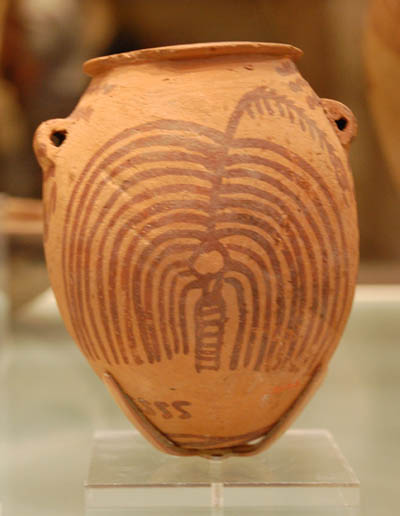
Tree of Life on Urn ca. 3600 BC
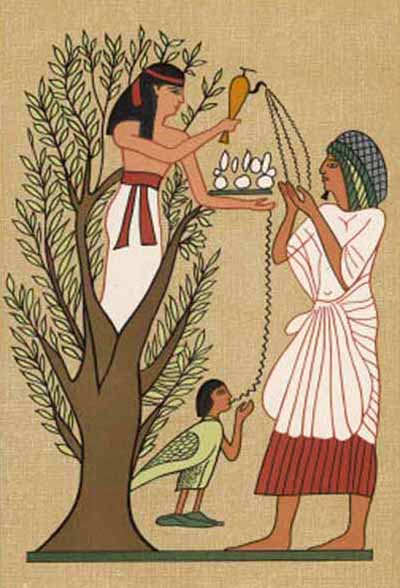
Tree of Life

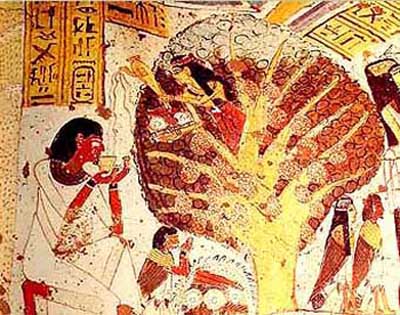
Tree Goddesses
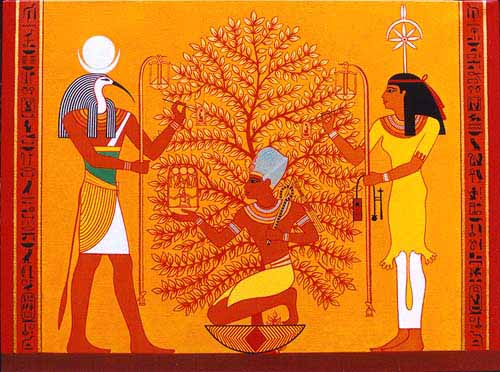
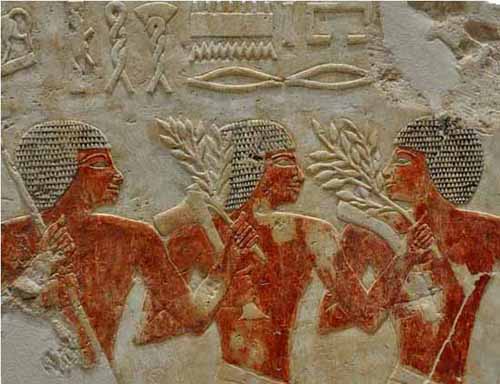
Sycamore trees used in ceremonies